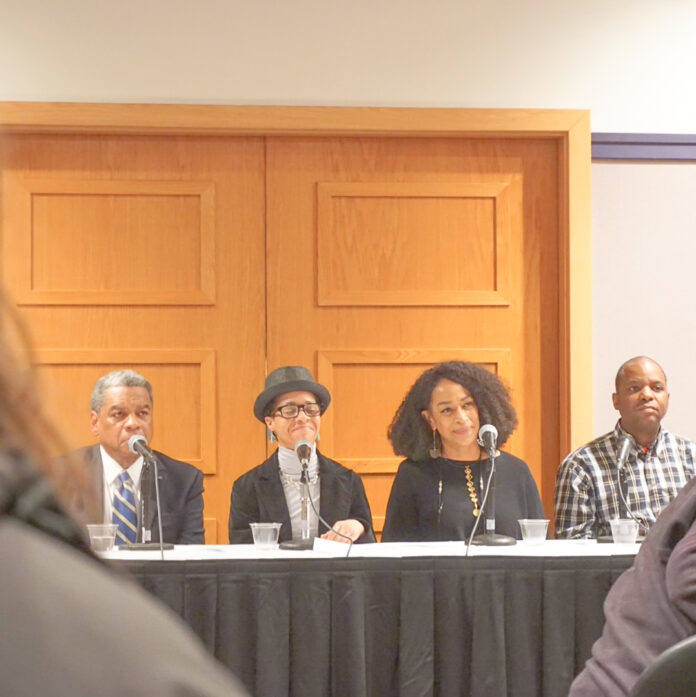
New York City is often hailed as the art center of the world with its Broadway lights and renowned art galleries, but some of the most inclusive, community-building art may be found in less expected places.
Such a place is the Lehigh Valley, which has a presence of small-scale artistic companies that often provide more opportunities for marginalized artists than larger associations in better-known cities. The art scene in downtown Allentown provided those opportunities for Deirdre Van Walters, a performing and teaching artist. She recalls a weekly art festival called Word Wednesdays, which she attributes to her initial involvement in the Valley’s art scene. Van Walters says, “Word Wednesdays was this great funky vibe that happened in downtown Allentown where there were live musicians and poets and singers, and I fit right on in there… and that led to me getting into the fold, and I feel fortunate and blessed that that fold did look like me… and it was not just a closed group, but it was really really welcoming in that respect.”
Van Walters went on to describe the overall artistic environment of the Valley at the time, saying “I didn’t see too many accommodating opportunities for me to fit in or to even try to audition for that role or this role. If it was casting for someone who looked like me, the character was just so conflicting from who I am that I chose not to represent in that particular role. So, that was my experience.”
When there is a lack of representation in this sense, artists such as Van Walters turn to smaller-scale artistic outlets in order to express themselves. Muhlenberg invited five Black artists who have found their place in the Lehigh Valley art scene. They explained how the Valley has provided them with an environment where there were opportunities for all voices, as well as how there is room for improvement in the Valley’s art scene. This included Van Walters, who took advantage of the opportunities the Lehigh Valley provided in becoming the president of a devised theater company called Basement Poetry. Van Walters was one of the five artists invited by Muhlenberg College for a conversation entitled “Traveling While Black Through the Arts,” organized by Lehigh University’s Zoellner Arts Center. This was part of a slate of community conversations being hosted until Mar. 31 as well as a cinematic virtual experience running until Mar. 31 entitled “Traveling While Black.”
Michael Freeman, an abstract artist based in Easton, Pennsylvania, is well-versed in how art can be used as an outlet for creativity and community building. As Freeman grew up with a vision impairment and a speech impediment, he used art and engagement with Black art specifically in order to express himself. Freeman’s abstract work and disabilities have not always made things easy for him in the Lehigh Valley, yet he reflects on how the presence and support of other Black artists in the community gave him confidence to pursue his passion. Freeman says, “Having seen other Black artists that I’ve been getting to know like Anthony Smith kind of embrace me in making very abstract artwork, I’m just here to embrace it and help others that look like me to do whatever they want to do, no matter what your disability is in life.”
As the artists discussed how they initially got involved with the arts, author and playwright Calvin Alexander Ramsey reflected on how the uncertainty of tomorrow that came with 9/11 motivated him to pursue his dream. Ramsey said, “I was flying out of Logan Airport, two days before the hijack, and after that, it just made me realize that if I want to do something with my writing, I really can’t keep putting it off. So, after that incident, that major tragedy, I just jumped into it. My children were pretty much almost grown, and so I started working on plays, and I’m very fortunate that I got my play produced… If you have a dream, just jump out there and do it. It’s going to haunt you until you do something with it.”
“If you have a dream, just jump out there and do it. It’s going to haunt you until you do something with it.”
Calvin Alexander Ramsey
Getting involved in the Lehigh Valley arts scene is all about networking according to Camille Armstrong, who—after performing in “Stomp” on Broadway—moved to the Lehigh Valley for her children to get a better education. Being the only artist among six first generation Jamaican-American siblings, Armstrong was determined to forge her own way and found that connecting to various people led to success. She says, “I think most of my experiences and most of my ‘ins’ in the art scene was getting to know people at the wrestling practice, at the cheerleading practice for my daughter or my son… and so it started just with one relationship, and then it grew into another.”
Although initially presenting this idea in a positive light, Armstrong later commented on its drawbacks with the comment, “There’s no limit to art, really, but the Lehigh Valley tends to limit themselves to the possibilities… you really think that you’re coming into a rich, artistic community until you try to get in, and if you don’t know someone’s grandmother or you just don’t know a person who’s the director of a Touchstone Theater then you’re just not getting in, and so how are we celebrating the art?”
“Yeah, I call it ‘the art mafia.’ There’s like three people that control the entire visual arts scene in the entire Valley—it’s kind of crazy,” responded Anthony Smith Jr. Smith is a visual and mixed-media artist, a professor of art at Northampton College and an artist in residence at the Banana Factory Art and Education Center.
While the Valley provides a fertile ground for a thriving art scene, not everyone views the area in this way. Smith noted that “we’re seen mostly as a community where artists are looking for cheap real estate to escape New York and Philly prices… I don’t think the locals necessarily see this space as a place where they can derive world class art, especially in the visual arts world.”
This leads to questions regarding the responsibilities of art consumers and how they can best support artists in the Lehigh Valley. Freeman sums up what all the artists responded and what applies to supporting all art with the comment, “Open your mind to something that’s different. Something that is not the norm, but that is beautiful and that you can see the beauty in. You might see something that somebody else might not see.”
Samantha Tempkin ‘25 is a theatre and media & communication double major and is thrilled to be joining the Weekly’s staff as an Assistant News Editor! She is also the co-president of KPC, Muhlenberg’s K-Pop club. When she is not writing for the paper, Sam loves singing, dancing, listening to music, seeing Broadway shows, watching Marvel movies, and hanging out with friends!






















